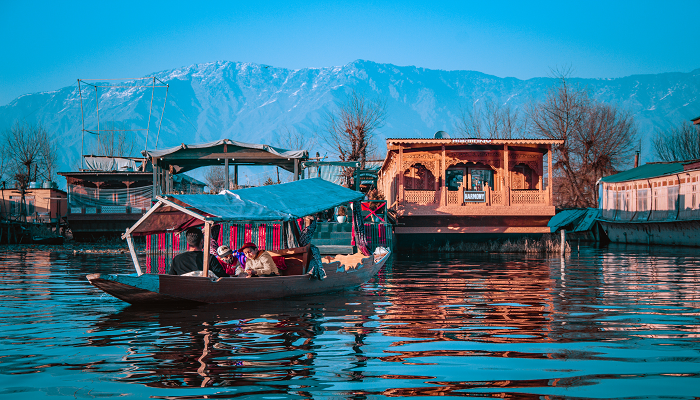
Srinagar (English: /ˈsriːnəɡər/ (![]() listen), Kashmiri pronunciation: [siriːnagar]) is the summer capital and largest city of the Indian-administered union territory of Jammu and Kashmir in the disputed Kashmir region. It lies in the Kashmir Valley along the banks of the Jhelum River, and the shores of Dal and Anchar lakes, between the Hari Parbat and Shankaracharya hills. The city is known for its natural environment, various gardens, waterfronts and houseboats. It is also known for traditional Kashmiri handicrafts like the Kashmir shawl (made of pashmina and cashmere wool), papier-mâché, wood carving, carpet weaving, and jewel making, as well as for dried fruits. It is the second-largest metropolitan area in the Himalayas (after Kathmandu, the capital of Nepal).
listen), Kashmiri pronunciation: [siriːnagar]) is the summer capital and largest city of the Indian-administered union territory of Jammu and Kashmir in the disputed Kashmir region. It lies in the Kashmir Valley along the banks of the Jhelum River, and the shores of Dal and Anchar lakes, between the Hari Parbat and Shankaracharya hills. The city is known for its natural environment, various gardens, waterfronts and houseboats. It is also known for traditional Kashmiri handicrafts like the Kashmir shawl (made of pashmina and cashmere wool), papier-mâché, wood carving, carpet weaving, and jewel making, as well as for dried fruits. It is the second-largest metropolitan area in the Himalayas (after Kathmandu, the capital of Nepal).
Founded in the 6th century during the rule of the Gonanda dynasty according to the Rajatarangini, the city took on the name of an earlier capital thought to have been founded by the Mauryas in its vicinity. The city remained the most important capital of the Kashmir Valley under the Hindu dynasties, and was a major centre of learning. During the 14th–16th centuries the city’s old town saw major expansions, particularly under the Shah Mir dynasty, whose kings used various parts of it as their capitals. It became the spiritual centre of Kashmir, and attracted several Sufi preachers. It also started to emerge as a hub of shawl weaving and other Kashmiri handicrafts. In the late 16th century the city became part of the Mughal Empire, many of whose emperors used it as their summer resort. Many Mughal gardens were built in the city and around Dal lake during this time, of which Shalimar and Nishat are the most well-known.
After passing through the hands of the Afghan Durranis and the Sikhs in the late 18th and early 19th century, it eventually became the summer capital of the Dogra kingdom of Jammu and Kashmir in 1846. The city became a popular tourist destination among Europeans and Indian elites during this time, with several hotels and its iconic houseboats being built. In 1952, the city became the summer capital of Jammu and Kashmir, a region administered by India as a state, with Jammu being its winter capital. It was the flashpoint of violence during the 1990s and early 2000s insurgency in the region. In 2019, it became the summer capital of a smaller region which is administered by India as a union territory, after the former state’s reorganisation.
According to the Rajatarangini of Kalhana, a capital city by the name of Srinagari was built in the Kashmir valley by Ashoka.[a] Kalhana calls this capital puranadhisthana, Sanskrit for ‘old capital’, identified as present-day Pandrethan, 3.5 kilometres south-east of Srinagar. A ‘new capital’ was built by king Pravarasena, called Parvarapura, in 6th century CE. Srinagari continued to be used as a name for this capital. This new capital was located at the base of the Hari Parbat hill on the right bank of the Jhelum, corresponding to the location of modern-day Srinagar. Kalhana describes the capital having several markets, mansions, wooden houses, grand temples and canals, and also refers to the Dal lake and Jhelum river. A long embankment was constructed on the Jhelum by Pravarasena to protect the city from floods, parts of which have survived to the present day. The two capitals are also mentioned in the chronicle of Chinese traveller Huein Tsang who visited the city in 631 CE. Although several other capitals of Kashmir were constructed by other rulers over the next few centuries, Pravarasena’s Srinagar survived as the capital.[b] The city was divided into several parts, each with its own guardian diety, which continue to be worshipped by Hindu Kashmiris. The 8th century scholar Adi Shankara visited the city and founded the Shankaracharya Temple here, at the site of the earlier Jyeshteshwara Temple. The city gradually extended to the left bank of the Jhelum river, and in the early 12th century the royal palace was shifted to this side.
No Review
Accommodation0
Transport0
Comfort0
Hospitality0
Food0